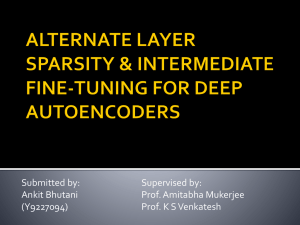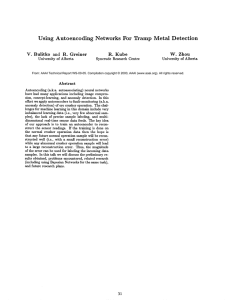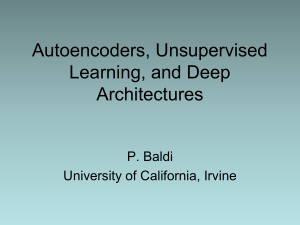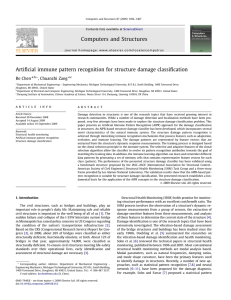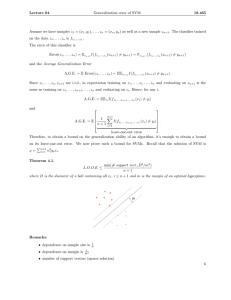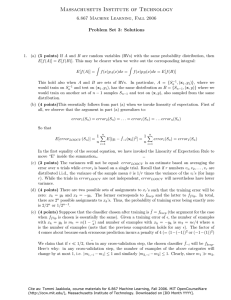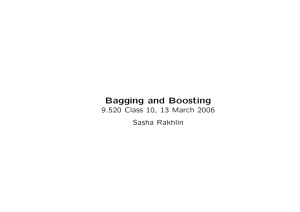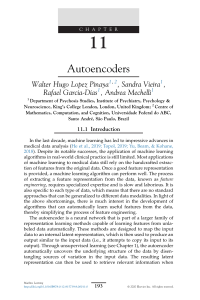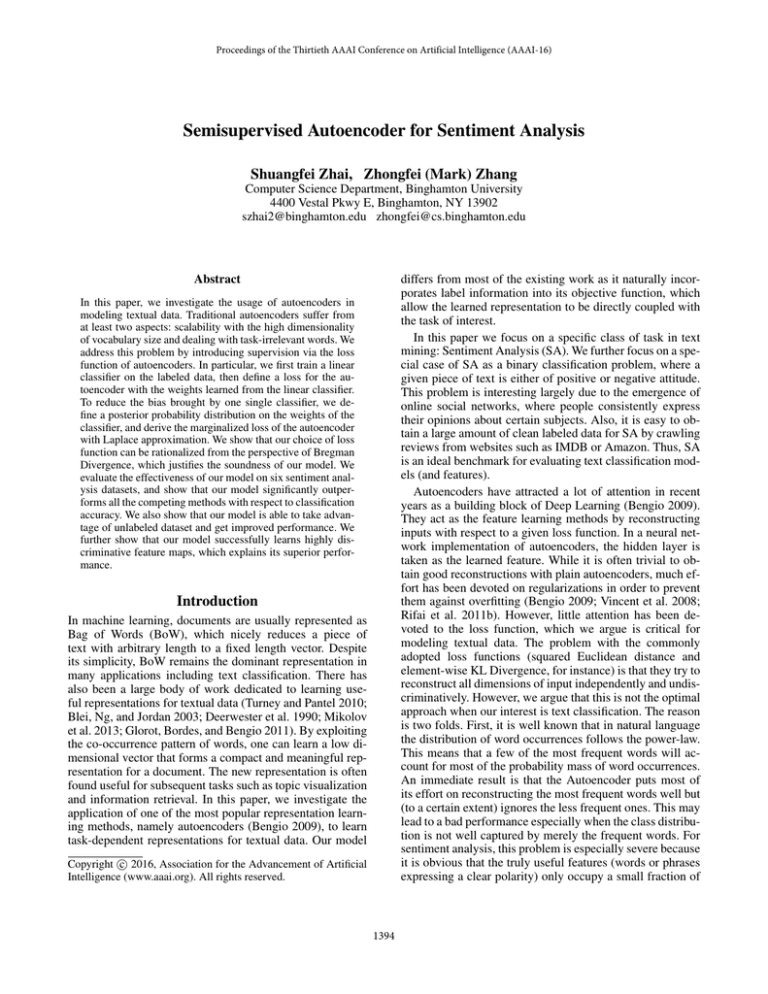
Proceedings of the Thirtieth AAAI Conference on Artificial Intelligence (AAAI-16)
Semisupervised Autoencoder for Sentiment Analysis
Shuangfei Zhai, Zhongfei (Mark) Zhang
Computer Science Department, Binghamton University
4400 Vestal Pkwy E, Binghamton, NY 13902
szhai2@binghamton.edu zhongfei@cs.binghamton.edu
differs from most of the existing work as it naturally incorporates label information into its objective function, which
allow the learned representation to be directly coupled with
the task of interest.
In this paper we focus on a specific class of task in text
mining: Sentiment Analysis (SA). We further focus on a special case of SA as a binary classification problem, where a
given piece of text is either of positive or negative attitude.
This problem is interesting largely due to the emergence of
online social networks, where people consistently express
their opinions about certain subjects. Also, it is easy to obtain a large amount of clean labeled data for SA by crawling
reviews from websites such as IMDB or Amazon. Thus, SA
is an ideal benchmark for evaluating text classification models (and features).
Autoencoders have attracted a lot of attention in recent
years as a building block of Deep Learning (Bengio 2009).
They act as the feature learning methods by reconstructing
inputs with respect to a given loss function. In a neural network implementation of autoencoders, the hidden layer is
taken as the learned feature. While it is often trivial to obtain good reconstructions with plain autoencoders, much effort has been devoted on regularizations in order to prevent
them against overfitting (Bengio 2009; Vincent et al. 2008;
Rifai et al. 2011b). However, little attention has been devoted to the loss function, which we argue is critical for
modeling textual data. The problem with the commonly
adopted loss functions (squared Euclidean distance and
element-wise KL Divergence, for instance) is that they try to
reconstruct all dimensions of input independently and undiscriminatively. However, we argue that this is not the optimal
approach when our interest is text classification. The reason
is two folds. First, it is well known that in natural language
the distribution of word occurrences follows the power-law.
This means that a few of the most frequent words will account for most of the probability mass of word occurrences.
An immediate result is that the Autoencoder puts most of
its effort on reconstructing the most frequent words well but
(to a certain extent) ignores the less frequent ones. This may
lead to a bad performance especially when the class distribution is not well captured by merely the frequent words. For
sentiment analysis, this problem is especially severe because
it is obvious that the truly useful features (words or phrases
expressing a clear polarity) only occupy a small fraction of
Abstract
In this paper, we investigate the usage of autoencoders in
modeling textual data. Traditional autoencoders suffer from
at least two aspects: scalability with the high dimensionality
of vocabulary size and dealing with task-irrelevant words. We
address this problem by introducing supervision via the loss
function of autoencoders. In particular, we first train a linear
classifier on the labeled data, then define a loss for the autoencoder with the weights learned from the linear classifier.
To reduce the bias brought by one single classifier, we define a posterior probability distribution on the weights of the
classifier, and derive the marginalized loss of the autoencoder
with Laplace approximation. We show that our choice of loss
function can be rationalized from the perspective of Bregman
Divergence, which justifies the soundness of our model. We
evaluate the effectiveness of our model on six sentiment analysis datasets, and show that our model significantly outperforms all the competing methods with respect to classification
accuracy. We also show that our model is able to take advantage of unlabeled dataset and get improved performance. We
further show that our model successfully learns highly discriminative feature maps, which explains its superior performance.
Introduction
In machine learning, documents are usually represented as
Bag of Words (BoW), which nicely reduces a piece of
text with arbitrary length to a fixed length vector. Despite
its simplicity, BoW remains the dominant representation in
many applications including text classification. There has
also been a large body of work dedicated to learning useful representations for textual data (Turney and Pantel 2010;
Blei, Ng, and Jordan 2003; Deerwester et al. 1990; Mikolov
et al. 2013; Glorot, Bordes, and Bengio 2011). By exploiting
the co-occurrence pattern of words, one can learn a low dimensional vector that forms a compact and meaningful representation for a document. The new representation is often
found useful for subsequent tasks such as topic visualization
and information retrieval. In this paper, we investigate the
application of one of the most popular representation learning methods, namely autoencoders (Bengio 2009), to learn
task-dependent representations for textual data. Our model
c 2016, Association for the Advancement of Artificial
Copyright Intelligence (www.aaai.org). All rights reserved.
1394
f (x) = (1+exp(−x))−1 in this paper; hi is the learned representation; x̃i is the reconstruction. A common approach is
to use tied weights by setting W = W ; this usually works
better as it speeds up learning and prevents overfitting at the
same time. For this reason, we always use tied weights in
this paper.
Autoencoders transform an unsupervised learning problem to a supervised one by the self reconstruction criteria.
This enables one to use all the tools developed for supervised
learning such as back propagation to efficiently train the autoencoders. Moreover, thanks to the nonlinear functions f
and g, autoencoders are able to learn non-linear and possibly
overcomplete representations, which give the model much
more expressive power than their linear counter parts such
as PCA (LSA) (Deerwester et al. 1990).
In this paper, we adopt one of the most popular variants
of autoencoders, namely Denoising Autoencoder. Denoising Autoencoder works by reconstructing the input from
a noised version of itself. The intuition is that a robust
model should be able to reconstruct the input well even in
the presence of noises, due to the high correlation among
features. For example, imagine deleting or adding a few
words from/to a document, the semantics should still remain
unchanged, thus the autoencoder should learn a consistent
representation from all the noisy inputs. In the high level,
Denoising Autoencoders are equivalent to ordinary autoencoders trained with dropout (Srivastava et al. 2014), which
has been shown as an effective regularizer for (deep) neural networks. Formally, let q(x̄|x) be a predefined noising
distribution, and x̄ be a noised sample of x: x̄ ∼ q(x̄|x).
The objective function takes the form of sum of expectations
over all the noisy samples:
Eq(x̄i |xi ) D(x̃i , xi )
min
(2)
i
s.t. hi = g(W x̄i + b), x̃i = f (W hi + b )
the whole vocabulary; and reconstructing irrelevant words
such as ’actor’ or ’movie’ very well is not likely to help
learn more useful representations to classify the sentiment
of movie reviews. Second, explicitly reconstructing all the
words in an input text is expensive, because the latent representation has to contain all aspects of the semantic space
carried by the words, even if they are completely irrelevant.
As the vocabulary size can easily reach the range of tens
of thousands even for a moderate sized dataset, the hidden
layer size has to be chosen very large to obtain a reasonable
reconstruction, which causes a huge waste of model capacity
and makes it difficult to scale to large problems.
In fact, the reasoning above applies to all the unsupervised learning methods in general, which we argue is one
of the most important problems to address in order to learn
task-specific representations. This naturally leads us to the
semisupervised approach, where label information is introduced to guide the feature learning procedure. In particular,
we propose a novel loss function for training autoencoders
that are directly coupled with the classification task. We first
train a linear classifier on BoW, then a Bregman Divergence
(Banerjee et al. 2004) is derived as the loss function of a
subsequent autoencoder. The new loss function gives the autoencoder the information about directions along which the
reconstruction should be accurate, and where larger reconstruction errors are tolerated. Informally, this can be considered as a weighting of words based on their correlations
with the class label: predictive words should be given large
weights in the reconstruction even they are not frequent
words, and vice versa. Furthermore, to reduce the bias introduced by the linear classifier, we take a Bayesian view
by defining a posterior distribution on the weights of the
classifier. We then approximate the posterior with Laplace
approximation and derive the marginalized loss function for
the autoencoder. We show that our model successfully learns
features that are highly discriminative with respect to class
labels, and also outperform all the competing methods evaluated by classification accuracy. Moreover, the derived loss
can also be applied to unlabeled data, which allows the
model to learn further better representations.
where we have slightly overloaded the notation to let x̃i denote the reconstruction calculated from the noised input x̄i .
While the marginal objective function requires infinite many
noised samples per data point, in practice it is sufficient to
simulate it stochastically. That is, for each example seen in
the stochastic gradient descent training, we randomly sample a x̄i from q(x̄i |xi ) and calculate the gradient with ordinary back propagation.
Model
Denoising Autoencoders
Autoencoders learn functions that can reconstruct the inputs.
They are typically implemented as a neural network with
one hidden layer, and one can extract the activation of the
hidden layer as the new representation. Mathematically, we
are given a collection of data points X = {xi }, xi ∈ Rd , i ∈
[1, m], the objective function of an autoencoder is thus:
D(x̃i , xi )
min
(1)
i
s.t. hi = g(W xi + b), x̃i = f (W hi + b )
Loss Function as Bregman Divergence
We then discuss the proper choice of the loss function D
in (2) as a specific form of Bregman Divergence. Bregman
Divergence (Banerjee et al. 2004) generalizes the notion of
distance in a d dimensional space. To be concrete, given two
data points x̃, x ∈ Rd and a convex function f (x) defined
on Rd , the Bregman Divergence of x̃ from x with respect to
f is:
T
Df (x̃, x) = f (x̃) − (f (x) + ∇f (x) (x̃ − x)).
where W ∈ Rk×d , b ∈ Rk , W ∈ Rd×k , b ∈ Rd are the
parameters to be learned; D is a loss function, such as the
squared Euclidean Distance x̃−x22 ; g and f are predefined
nonlinear functions, which we set as g(x) = max(0, x),
(3)
Namely, Bregman Divergence measures the distance between two points x̃, x as the deviation between the function
value of f and the linear approximation of f around x at x̃.
1395
and analyzed similarly. Let us denote {xi }, xi ∈ Rd as the
collection of samples, and {yi }, yi ∈ {1, −1} as the class
labels; the objective function SVM2 is:
(max(0, 1 − yi θT xi ))2 + λθ2 .
(5)
L(θ) =
Two of the most commonly used loss functions for autoencoders are the squared Euclidean distance and elementwise KL divergence. It is not difficult to verify that they both
fall into this family by choosing f as the squared 2 norm
and the sum of element-wise entropy respectively. What the
two loss functions have in common is that they make no
distinction among dimensions of the input. In other words,
each dimension of the input is pushed to be reconstructed
equally well. While autoencoders trained in this way have
been shown to work very well on image data, learning much
more interesting and useful features than the original pixel
intensity features, they are less appropriate for modeling textual data. The reason is two folds. First, textual data are
extremely sparse and high dimensional, where the dimensionality is equal to the vocabulary size. To maintain all the
information of the input in the hidden layer, a very large
layer size must be adopted, which makes the training cost
extremely large. Second, ordinary autoencoders are not able
to deal with the power law of word distributions, where a few
of the most frequent words account for most of the word occurrences. As a result, frequent words naturally gain favor
to being reconstructed accurately, and rare words tend to be
reconstructed with less precision. This problem is also analogous to the imbalanced classification setting. This is especially problematic when frequent words carry little information about the task of interest, which is not uncommon.
Examples include stop words (the, a, this, from) and topic
related terms (movie, watch, actress) in a movie review sentiment analysis task.
i
Here θ ∈ Rd is the weight; λ is the weight decay parameter.
Equation (5) is continuous and differentiable everywhere
with respect to θ, so the model can be easily trained with
stochastic gradient descent. The next (and most critical) step
of our approach is to transfer label information from the linear classifier to the autoencoder. With this in mind, we examine the loss induced by each sample as a function of the
input, while with θ fixed:
f (xi ) = (max(0, 1 − yi θT xi ))2
Note that f (xi ) is defined on the input space Rd , which
should be contrasted with L(θ) in Equation (5) which is a
function of θ. We are interested in f (xi ) because if we consider moving each input xi to x̃i , f (xi ) indicates the direction along which the loss is sensitive to. If we think of x̃
as the reconstruction of xi obtained from an autoencoder, a
good x̃i should be in a way such that the deviation of x̃i from
xi is small evaluated by f (xi ). In other words, we would
like x̃i to still be correctly classified by the pretrained linear
classifier. Therefore, f (xi ) should be a much better function
to evaluate the deviation of two samples. if we can derive a
Bregman Divergence from f (xi ) and use it as the loss function of the subsequent autoencoder training, the autoencoder
should be guided to give reconstruction errors that do not
confuse the classifier. Note that f (xi ) is a quadratic function of xi whenever f (xi ) > 0, so we only need to derive
the Hessian matrix in order to achieve the Bregman Divergence. The Hessian follows as:
Semisupervised Autoencoder with Bregman
Divergence
To address the problems mentioned above, we propose to
introduce supervision to the training of autoencoders. To
achieve this, we first train a linear classifier on Bag of Words,
and then use the weight of the learned classifier to define a
new loss function for the autoencoder. Now let us first describe our choice of loss function, and then elaborate the
motivation later:
D(x̃, x) = (θT (x̃ − x))2 .
(6)
H(xi ) =
(4)
θθT ,
0,
if 1 − yi θT xi > 0
otherwise.
(7)
Recall that for a quadratic function with Hessian matrix H,
the Bregman Divergence is simply (x̃ − x)T H(x̃ − x); then
we have:
T
(θ (x̃i − xi ))2 , if 1 − yi θT xi > 0
D(x̃i , xi ) =
(8)
0,
otherwise
where θ ∈ Rd are the weights of the linear classifier, and we
have omitted the bias for simplicity. Before we delve into
more details, note that Equation (4) is a valid distance, as
it is non-negative and reaches zeros if and only if x̃ = x.
Moreover, the reconstruction error is only measured after
projecting on θ; this guides the reconstruction to be accurate
only along directions where the linear classifier is sensitive
to. Note also that Equation (4) on the one hand uses label
information (θ has been trained with labeled data), on the
other hand no explicit labels are directly referred to (only requires xi ). Thus one is able to train an autoencoder on both
labeled and unlabeled data with the loss function in Equation (4). This subtlety distinguishes our method from pure
supervised or unsupervised learning, and allows us to enjoy
the benefit from both worlds.
As a design choice, we consider SVM with squared hinge
loss (SVM2) and 2 regularization as the linear classifier,
but other classifiers such as Logistic Regression can be used
In words, Equation (8) says that we measure the reconstruction loss for difficult examples (those that satisfy 1 −
yi θT xi > 0) with Equation (4); and there is no reconstruction loss at all for easy examples. This discrimination is undesirable, because in this case the Autoencoder would completely ignore easy examples, and there is no way to guarantee that the x̃i can be correctly classified. Actually, this
split is just an artifact of the hinge loss and the asymmetrical property of Bregman Divergence. Hence, we perform a
simple correction by ignoring the condition in Equation (8),
which basically pretends that all the examples induce a loss.
This directly yields the loss function as in Equation (4).
1396
The Bayesian Marginalization
Table 1: Statistics of the datasets.
In principle, one may directly apply Equation (4) as the loss
function in place of the squared Euclidean distance and train
an autoencoder. However, doing so might introduce a bias
brought by one single classifier. As a remedy, we resort to
the Bayesian approach, which defines a probability distribution over θ. Although SVM2 is not a probabilistic classifier
like Logistic Regression, we can borrow the idea of Energy
Based Model (Bengio 2009) and use L(θ) as the negative
log likelihood of the following distribution:
# train
# test
# unlabeled
# features
% positive
DVD
10,000
2,960
N/A
10,537
49.85
music
18,000
2,661
N/A
13,099
50.16
electronics
6,000
2,862
N/A
5,091
49.78
kitchenware
6,000
1,691
N/A
3,907
50.08
Experiments
(θT (x̃ − x))2 p(θ)dθ.
Datasets
(10)
We evaluate our model on six Sentiment Analysis benchmarks. The first one is the IMDB dataset 1 (Maas et al.
2011), which consists of movie reviews collected from
IMDB. The IMDB dataset is one of the largest sentiment
analysis dataset that is publicly available; it also comes with
an unlabeled set which allows us to evaluate semisupervised
learning methods. The rest five datasets are all collected
from Amazon 2 (Blitzer, Dredze, and Pereira 2007), which
corresponds to the reviews of five different products: books,
DVDs, music, electronics, kitchenware. All the six datasets
are already tokenized as either uni-gram or bi-gram features.
For computational reasons, we only select the words that
occur in at least 30 training examples. We summarize the
statistics of datasets in Table 1.
Obviously there is now no closed form expression for
D(x̃, x). To solve it one could use sampling methods such
as MCMC, which provides unbiased estimates of the expectation but could be slow in practice. Instead, we use
the Laplace approximation, which approximates p(θ) by a
Gaussian distribution p̃(θ) = N (θ̂, Σ). As estimating the
full covariance matrix is prohibitive, we further constrain Σ
to be diagonal. The benefit of doing so is that the expectation
can now be computed directly in closed form. To see this, by
simply replacing p(θ) with p̃(θ) in Equation (11):
D(x̃, x) =Eθ∼p̃(θ) (θT (x̃ − x))2
=(x̃ − x)T Eθ∼p̃(θ) (θθT )(x̃ − x)
Methods
=(x̃ − x)T (θ̂θ̂T + Σ)(x̃ − x)
1
2
books
10,000
3,105
N/A
9,849
49.81
to the squared Euclidean distance after performing elementwise normalizing the input using all difficult examples. The
effect of this normalization is that the reconstruction errors
of frequent words are down weighted; on the other hand, discriminative words are given higher weights as they would
occur less frequently in difficult examples. Note that it is
important to use a relatively large β in order to avoid the
variance term dominating the mean term. In other words, we
need to ensure p(θ) to be reasonable peaked around θ̂ to effective take advantage of label information.
exp(−βL(θ))
(9)
exp(−βL(θ))dθ
where β > 0 is the temperature parameter which controls
the shape of the distribution p. Note that the larger β is, the
sharper p will be. In the extreme case, p(θ) is reduced to a
uniform distribution as β approaches 0, and collapses into a
single δ function as β goes to positive infinity.
Given p(θ), we rewrite Equation (4) as an expectation
over θ:
p(θ) = D(x̃, x) = Eθ∼p(θ) (θT (x̃ − x))2 =
IMDB
25,000
25,000
50,000
8,876
50
• Bag of Words (BoW). Instead of using the raw word
counts directly, we take a simple step of data normalization:
log(1 + ci,j )
(13)
xi,j =
maxj log(1 + ci,j )
where ci,j denotes the number of occurrences of the jth
word in the ith document, xi,j denotes the normalized
count. We choose this normalization because it preserves
the sparsity of the Bag of Words features; also each feature element is normalized to the range [0, 1]. Note that
the very same normalized Bag of Words features are fed
into the autoencoders.
• Denoising Autoencoder (DAE) (Vincent et al. 2008).
This refers to the regular Denoising Autoencoder defined
in Equation (1) with squared Euclidean distance loss:
1
2
=(θ̂T (x̃ − x))2 + (Σ (x̃ − x))T (Σ (x̃ − x)).
(11)
where D now involves two parts, corresponding to the mean
and variance term of the Gaussian distribution respectively.
Now let us derive p̃(θ) for p(θ). In Laplace approximation, θ̂
is chosen as the mode of p(θ), which is exactly the solution
to the SVM2 optimization problem. For Σ, we have:
∂ 2 L(θ) −1
))
∂θ2
1
= (diag(
I(1 − yi θT xi > 0)x2i ))−1
β
i
Σ =(diag(
(12)
Here we have overridden diag but letting it denote a diagonal matrix induced either by a square matrix or a vector; I
is the indicator function; (·)−1 denotes matrix inverse. Interestingly, the second term in Equation (11) is now equivalent
1
2
1397
http://ai.stanford.edu/ amaas/data/sentiment/
http://www.cs.jhu.edu/ mdredze/datasets/sentiment/
D(x̃, x) = x̃ − x22 . This is also used in (Glorot, Bordes, and Bengio 2011) on the Amazon datasets for domain adaptation. We use ReLu max(0, x) as the activation function, and Sigmoid as the decoding function.
LrDrop is the second best method that we have tested.
Thanks to the usage of dropout regularization, it consistently outperforms BoW, and achieves the best results on
two (smaller) datasets. Compared with LrDrop, it appears
that our model works better on large datasets (≈ 10K words,
more than 10K training examples) than smaller ones. This
indicates that in high dimensional spaces with sufficient
samples, SBDAE benefits from learning a nonlinear feature
transformation that disentangles the underlying factors of
variation, while LrDrop is incapable of doing so due to its
nature as a linear classifier.
As the training of the autoencoder part of SBDAE does
not require the availability of labels, we also try incorporating unlabeled data after learning the linear classifier in SBDAE. As shown in Table 2, doing so further improves the
performance over using labeled data only. This justifies that
it is possible to bootstrap from a relatively small amount of
labeled data and learn better representations with more unlabeled data with SBDAE.
To gain more insights of the results, we further visualize the filters learned by SBDAE and DAE on the IMDB
dataset in Table 3. In particular, we show the top 5 most
activated and deactivated words of the first 8 filters (corresponding to the first 8 rows of W ) of SBDAE and DAE, respectively. First of all, it seems very difficult to make sense
of the filters of DAE as they are mostly common words with
no clear co-occurrence pattern. By comparison, if we look at
the filters from SBDAE, they are mostly sensitive to words
that demonstrate clear polarity. In particular, all the 8 filters
seem to be most activated by certain negative words, and are
most deactivated by certain positive words. In this way, the
activation of each filter of SBDAE is much more indicative
of the polarity than that of DAE, which explains the better
performance of SBDAE over DAE. Note that this difference
only comes from reweighting the reconstruction errors in a
certain way, with no explicit usage of labels.
• Denoising Autoencoder with Finetuning (DAE+) (Vincent et al. 2008). This denotes the common approach to
continue training an DAE on labeled data by replacing
the decoding part of DAE with a Softmax layer.
• Feedforward Neural Network (NN). This is the standard
fully connected neural network with one hidden layer and
random initialization. We use the same activation function
as that in Autoencoders, i.e., ReLU.
• Logistic Regression with Dropout (LrDrop) (Wager,
Wang, and Liang 2013). This is a model where logistic
regression is regularized with the marginalized dropout
noise. LrDrop differs from our approach as it uses feature
noising as an explicit regularization. Another difference
is that our model is able to learn nonlinear representations, not merely a classifier, and thus is potentially able
to model more complicated patterns in data.
• Semisupervised Bregman Divergence Autoencoder (SBDAE). This corresponds to our model with Denoising Autoencoder as the feature learner. The training process is
roughly equivalent to training on BoW followed by the
training of DAE, except that the loss function of DAE is
replaced with the loss function defined in Equation (11).
We cross validate β from the set {104 , 105 , 106 , 107 , 108 }
(note that larger β corresponds to weaker Bayesian regularization).
• Semisupervised Bregman Divergence Autoencoder with
Finetuning (SBDAE+).
Note that except for BoW and LrDrop, all the other methods require a predefined dimensionality of representation.
We use fixed sizes on all the datasets. For SBDAE and NN, a
small hidden size is sufficient, so we use 200. For DAE, we
observe that it benefits from very large hidden sizes; however, due to computational constraints, we take 2000. For
BoW, DAE, SBDAE, we use SVM2 as the classifier. All the
models are trained with mini-batch Stochastic Gradient Descent with momentum of 0.9.
Related Work and Discussion
Our work falls into the general category of learning representations for text data. In particular, there have been a lot
of efforts that try to learn compact representations for either
words or documents (Turney and Pantel 2010; Blei, Ng, and
Jordan 2003; Deerwester et al. 1990; Mikolov et al. 2013;
Le and Mikolov 2014; Maas et al. 2011). LDA (Blei, Ng,
and Jordan 2003) explicitly learns a set of topics, each of
which is defined as a distribution on words; a document
is thus represented as the posterior distribution on topics,
which is a fixed-length, non-negative vector. Closely related
are matrix factorization models such as LSA (Deerwester
et al. 1990) and Non-negative Matrix Factorization (NMF)
(Xu, Liu, and Gong 2003). While LSA factorizes the docterm matrix via Singular Value Decomposition, NMF learns
non-negative basis and coefficient vectors. Similar to these
efforts, our model also works directly on the doc-term matrix. However, thanks to the usage of autoencoder, the representation for documents are calculated instantly via direct
matrix product, which eliminates the need of expensive inference. Our work also distinguishes itself from other work
Results
We first summarize the results as in classification error rate
in Table 2. First of all, our model consistently beats BoW
with a margin, and it achieves the best results on four (larger)
datasets out of six. On the other hand, DAE, DAE+ and NN
all fail to outperform BoW, although they share the same
architecture as nonlinear classifiers. This suggests that SBDAE be able to learn a much better nonlinear feature transformation function by training with a more informed objective (than that of DAE). Moreover, note also that finetuning on labeled set (DAE+) significantly improves the performance of DAE, which is ultimately on a par with training a
neural net with random initialization (NN). However, finetuning offers little help to SBDAE, as it is already implicitly
guided by labels during the training.
1398
Table 2: Left: our model achieves the best results on four (large ones) out of six datasets. Right: our model is able to take
advantage of unlabeled data and gain better performance.
BoW
DAE
DAE+
NN
LrDrop
SBDAE
SBDAE+
books
10.76
15.10
11.40
11.05
9.53
9.16
9.12
DVD
11.82
15.64
12.09
11.89
10.95
10.90
10.90
music
11.80
15.44
11.80
11.42
10.90
10.59
10.58
electronics
10.41
14.74
11.53
11.15
9.81
10.02
10.01
kitchenware
9.34
12.48
9.23
9.16
8.69
8.87
8.83
IMDB
11.48
14.60
11.48
11.60
10.88
10.52
10.50
IMDB + unlabled
N/A
13.28
11.47
N/A
10.73
10.42
10.41
Table 3: Visualization of learned feature maps. From top to bottom: most activated and deactivated words for SBDAE; most
activated and deactivated words for DAE.
nothing
cannon
outrageously
lends
teacher
first
classic
man
hard
still
disappointing
worst
unfortunately
terrible
predictable
tears
wonderfully
helps
awesome
terrific
badly
disappointing
annoying
worst
poorly
loved
finest
noir
magnificent
scared
save
redeeming
awful
sucks
convince
amazing
incredible
funniest
unforgettable
captures
even
attempt
unfunny
couldn’t
worst
excellent
surprisingly
beauty
unexpected
appreciated
dull
fails
stupid
worst
avoid
perfect
?
powerful
excellent
favorite
excuse
had
failed
rest
he
years
terrific
peter
cool
allows
ridiculously
dean
none
ruined
attempt
with
best
recommended
perfect
heart
long
worst
kids
anyone
trying
done
find
before
work
watching
wasn’t
guy
music
work
now
least
book
day
actors
classic
probably
fan
kind
years
place
go
trying
looks
everyone
performances
to
the
and
this
shows
kind
takes
special
now
someone
making
give
performances
least
comes
recommend
instead
wife
shows
night
laugh
find
where
before
ever
although
everyone
anything
comes
away
tv
might
found
kids
having
ending
once
wasn’t
american
sense
someone
yet
goes
away
poor
worth
interesting
isn’t
rather
around
generalize to documents. MTC (Rifai et al. 2011a) is another
work that models the interaction of autoencoders and classifiers. However, their training of autoencoders is purely unsupervised, the interaction comes into play by requiring the
classifier to be invariant along the tangents of the learned
data manifold. It is not difficult to see that the assumption
of MTC would not hold when the class labels did not align
well with the data manifold, which is a situation our model
does not suffer from.
as a semisupervised representation learning model, where
label information can be effectively leveraged.
Recently, there has also been an active thread of research
on learning word representations. Notably, (Mikolov et al.
2013) shows that we can learn interesting word embeddings
via very simple architecture on a large amount of unlabeled dataset. Moreover, (Le and Mikolov 2014) proposed
to jointly learn representations for sentences and paragraphs
together with words in a similar unsupervised fashion. While
our work does not explicitly model the representations for
words, it is straightforward to incorporate this idea by adding
an additional linear layer at the bottom of the autoencoder.
From the perspective of machine learning methodology,
our approach resembles the idea of layer-wise pretraining
in deep Neural Networks (Bengio 2009). Our model differs from the traditional training procedure of autoencoders
in that we effectively utilize the label information to guide
the representation learning. Related idea has been proposed
in (Socher et al. 2011), where they train Recursive autoencoders on sentences jointly with prediction of sentiment.
Due to the delicate recursive architecture, their model only
works on sentences with given parsing trees, and could not
Conclusion
In this paper, we have proposed a novel extension to autoencoders for learning task-specific representations for textual
data. We have generalized the traditional autoencoders by
relaxing their loss function to the Bregman Divergence, and
then derived a discriminative loss function from the label
information. Experiments on text classification benchmarks
have shown that our model significantly outperforms Bag of
Words, traditional Denoising Autoencoder, and other competing methods. We have also qualitatively visualized that
our model successfully learns discriminative features, which
unsupervised methods fail to do.
1399
Acknowledgments
Socher, R.; Pennington, J.; Huang, E. H.; Ng, A. Y.; and
Manning, C. D. 2011. Semi-supervised recursive autoencoders for predicting sentiment distributions. In Proceedings
of the 2011 Conference on Empirical Methods in Natural
Language Processing, EMNLP 2011, 27-31 July 2011, John
McIntyre Conference Centre, Edinburgh, UK, A meeting of
SIGDAT, a Special Interest Group of the ACL, 151–161.
Srivastava, N.; Hinton, G. E.; Krizhevsky, A.; Sutskever, I.;
and Salakhutdinov, R. 2014. Dropout: a simple way to prevent neural networks from overfitting. Journal of Machine
Learning Research 15(1):1929–1958.
Turney, P. D., and Pantel, P. 2010. From frequency to meaning: Vector space models of semantics. J. Artif. Intell. Res.
(JAIR) 37:141–188.
Vincent, P.; Larochelle, H.; Bengio, Y.; and Manzagol, P.
2008. Extracting and composing robust features with denoising autoencoders. In Machine Learning, Proceedings
of the Twenty-Fifth International Conference (ICML 2008),
Helsinki, Finland, June 5-9, 2008, 1096–1103.
Wager, S.; Wang, S. I.; and Liang, P. 2013. Dropout training as adaptive regularization. In Advances in Neural Information Processing Systems 26: 27th Annual Conference on
Neural Information Processing Systems 2013. Proceedings
of a meeting held December 5-8, 2013, Lake Tahoe, Nevada,
United States., 351–359.
Xu, W.; Liu, X.; and Gong, Y. 2003. Document clustering
based on non-negative matrix factorization. In SIGIR 2003:
Proceedings of the 26th Annual International ACM SIGIR
Conference on Research and Development in Information
Retrieval, July 28 - August 1, 2003, Toronto, Canada, 267–
273.
This work is supported in part by NSF (CCF-1017828).
References
Banerjee, A.; Merugu, S.; Dhillon, I. S.; and Ghosh, J. 2004.
Clustering with bregman divergences. In Proceedings of
the Fourth SIAM International Conference on Data Mining,
Lake Buena Vista, Florida, USA, April 22-24, 2004, 234–
245.
Bengio, Y. 2009. Learning deep architectures for AI. Foundations and Trends in Machine Learning 2(1):1–127.
Blei, D. M.; Ng, A. Y.; and Jordan, M. I. 2003. Latent
dirichlet allocation. Journal of Machine Learning Research
3:993–1022.
Blitzer, J.; Dredze, M.; and Pereira, F. 2007. Biographies,
bollywood, boom-boxes and blenders: Domain adaptation
for sentiment classification. In ACL 2007, Proceedings of the
45th Annual Meeting of the Association for Computational
Linguistics, June 23-30, 2007, Prague, Czech Republic.
Deerwester, S. C.; Dumais, S. T.; Landauer, T. K.; Furnas,
G. W.; and Harshman, R. A. 1990. Indexing by latent semantic analysis. JASIS 41(6):391–407.
Glorot, X.; Bordes, A.; and Bengio, Y. 2011. Domain adaptation for large-scale sentiment classification: A deep learning approach. In Proceedings of the 28th International Conference on Machine Learning, ICML 2011, Bellevue, Washington, USA, June 28 - July 2, 2011, 513–520.
Le, Q. V., and Mikolov, T. 2014. Distributed representations
of sentences and documents. In Proceedings of the 31th International Conference on Machine Learning, ICML 2014,
Beijing, China, 21-26 June 2014, 1188–1196.
Maas, A. L.; Daly, R. E.; Pham, P. T.; Huang, D.; Ng, A. Y.;
and Potts, C. 2011. Learning word vectors for sentiment
analysis. In The 49th Annual Meeting of the Association for
Computational Linguistics: Human Language Technologies,
Proceedings of the Conference, 19-24 June, 2011, Portland,
Oregon, USA, 142–150.
Mikolov, T.; Sutskever, I.; Chen, K.; Corrado, G. S.; and
Dean, J. 2013. Distributed representations of words and
phrases and their compositionality. In Advances in Neural
Information Processing Systems 26: 27th Annual Conference on Neural Information Processing Systems 2013. Proceedings of a meeting held December 5-8, 2013, Lake Tahoe,
Nevada, United States., 3111–3119.
Rifai, S.; Dauphin, Y.; Vincent, P.; Bengio, Y.; and Muller,
X. 2011a. The manifold tangent classifier. In Advances
in Neural Information Processing Systems 24: 25th Annual Conference on Neural Information Processing Systems
2011. Proceedings of a meeting held 12-14 December 2011,
Granada, Spain., 2294–2302.
Rifai, S.; Vincent, P.; Muller, X.; Glorot, X.; and Bengio, Y.
2011b. Contractive auto-encoders: Explicit invariance during feature extraction. In Proceedings of the 28th International Conference on Machine Learning, ICML 2011, Bellevue, Washington, USA, June 28 - July 2, 2011, 833–840.
1400

